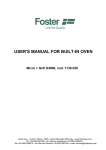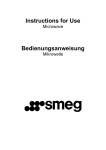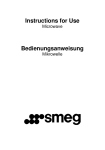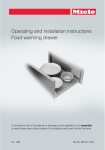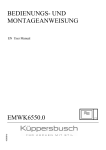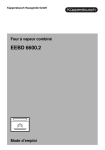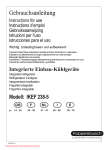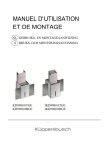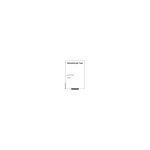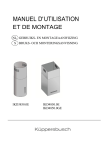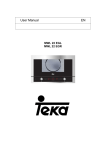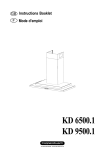Download Küppersbusch EMWK 6260.0
Transcript
BEDIENUNGS- UND MONTAGEANWEISUNG EN User Manual EMWG6260 EN Contents Safety Instructions ................................................................................................................................. 26 Installation instructions........................................................................................................................... 28 The advantages of microwaves ................................................................................................................ 29 Description of microwave oven ................................................................................................................ 30 Basic settings ........................................................................................................................................ 32 Basic functions ...................................................................................................................................... 33 When the oven is working... .................................................................................................................... 35 Defrosting ............................................................................................................................................. 36 Cooking with a microwave oven ............................................................................................................... 38 Cooking with the grill .............................................................................................................................. 40 What kind of ovenware can be used? ........................................................................................................ 43 Oven Cleaning and Maintenance ............................................................................................................... 45 What should I do if the oven doesn’t work? ............................................................................................... 47 Technical characteristics ......................................................................................................................... 48 Installation ............................................................................................................................................ 50 Dear Costumer: Thank you for choosing this Küppersbusch product. We ask you to read the instructions in this booklet very carefully as this will allow you to get the best results from using it. KEEP THE DOCUMENTATION OF THIS PRODUCT FOR FUTURE REFERENCE. Always keep the instruction manual handy. If you lend the Steam oven to someone else give them the manual as well! The user manual is also available for download at www.kueppersbusch.de. 25 EN Safety Instructions • Warning! Do not leave the oven unsupervised. • Warning! If you see smoke or fire, keep the door closed in order to smother the flames. Switch off the oven and take the plug out of the socket or cut off the oven power supply. • WARNING: The appliance and its accessible parts become hot during use. Care should be taken to avoid touching heating elements. Children less than 8 years of age age shall be kept away unless continuously supervised. • This appliance can be used by children aged from 8 years and above and persons with reduced physical, sensory or mental capa bilities or lack of experience and knowledge if they have been given supervision or instruction supervision concerning use of the appliance in a safe way and understand the hazards involved. Children shall not play with the appliance. Cleaning and user maintenance shall not be made by children without supervision. 26 • Children must be supervised to ensure that they do not play with the appliance. Use the safety locks. • Warning! During use the appliance becomes very hot. Care should be taken to avoid touching heating elements inside the oven. RISK OF BURNS! • Warning! Accessible parts may become hot during use. Young children should be kept away. • Warning! When opening the door during or upon completion of the cooking cycle, be careful of the flow of hot air and/or steam and water drops coming out of the cooking chamber. Step back or to the side to avoid burns. • Warning! Make sure you never catch the power cables of other electrical appliances in the hot door or the oven. The cable insulation may melt. Danger of shortshort-circuiting! This oven is exclusively for domestic use! The appliance is designed for use in the home for preparing food. No liability is assumed for any damage caused by improper or incorrect use. EN Safety Instructions Avoid damaging the oven or other dangerous situations by following these instructions: • Please cover the socket inside the oven as you are not using the food probe. This will prevent possible damages.. • Only use the recommended food probe for this oven. • This will prevent possible damages on the appliance • Do not cover or obstruct the ventilation openings. openings • Do not keep any inflammable inflammable object inside the oven as it may burn if the oven is switched on. • Do not use the oven as a pantry. pantry • Do not pour spirits (e.g. brandy, whisky, schnapps, etc.) over hot food. Danger of explosion! • Accessories such as wire racks and trays, etc. get hot in the cooking space. Always wear protective gloves or use oven cloths. • To avoid being burnt, burnt always use oven gloves for handling dishes and containers and touching the oven. • Do not lean or sit on the open oven door. This may damage the oven, especially in the hinge zone. The door can bear a maximum weight of 8 kg. • The racks can bear a maximum load of 8 kg. To avoid damaging the oven, do not exceed this load. Cleaning: • The appliance will remain hot for some time after it is switched off and cool down only slowly to room temperature. Please allow sufficient time for the appliance to cool down before, for instance, cleaning it. • Do not use harsh abrasive cleaners or sharp metal scrapers to clean the oven door glass since they can scratch the surface, which may result in shattering of the glass. • Do not use high pressure or steam jet cleaning appliances. • Please follow the instructions regarding cleaning in the section “Oven Cleaning and Maintenance”. Repairs: • If the power cable is damaged it should be substituted by the manufacturer, authorised agents or technicians qualified for this task in order to avoid dangerous situations. Furthermore, special tools are required for this task. Repair and maintenance work, especially of current carrying parts, can only be carried out by technicians authorized by the manufacturer. 27 EN Installation instructions Before installation After installation Check that the input voltage indicated on the characteristics plate is the same as the voltage of the power outlet you are going to use. The oven is equipped with a power cable and a plug for single phase current. Open the oven door and take out all the accessories and remove the packing material. Do not remove the mica cover on the ceiling of the interior! This cover stops fat and pieces of food damaging the microwave generator. Warning! Warning! The front surface of the oven may be wrapped with a protective film. film Before using the oven for the first time, carefully remove this film, starting on the inside. Make sure that the oven is not damaged in any way. Check that the oven door closes correctly and that the interior of the door and the front of the oven opening are not damaged. If you find any damage contact the Technical Assistance Service. DO NOT USE THE OVEN if the power cable or the plug are damaged, if the oven does not function correctly or if it has been damaged or dropped. Contact the Technical Assistance Service. Put the oven on a flat and stable surface. The oven must not be put close to any sources of heat, radios or televisions. If the oven is to be installed on a permanent basis it should be installed by a qualified technician. In such a case, the oven should be connected to a circuit with an all-pole circuit breaker with a minimum separation of 3 mm between contacts. WARNING: THE OVEN MUST BE EARTHED. The manufacturer and retailers do not accept responsibility for any damage that may be caused to people, animals or property if these installation instructions are not observed. The oven only functions when the door is closed correctly. After the first use, clean the inside of the oven and the accessories, following the cleaning instructions given in the section “Oven cleaning and maintenance”. Fit the Turntable support in the centre of the oven cavity and put the Turntable ring and the Turntable plate on top, making sure they slot in. Whenever you use the microwave, the turntable plate and the respective accessories must be inside and correctly fitted. The turntable plate can rotate in both directions. During installation, make sure that the power cable does does not come into contact with any moisture or objects with sharp edges behind the oven. High temperatures can damage the cable. Warning: after the oven is installed you must make sure you can access the plug. During installation, follow the instructions supplied separately. 28 EN The advantages of microwaves In conventional ovens, heat radiated by electrical elements or gas burners slowly penetrates the food from outside to inside. On account of this there is a major amount of energy is wasted heating the air, the oven components and the food containers. In a microwave oven, heat is generated by the food itself and the heat travels from inside to outside. No heat is lost to the air, the walls of the oven cavity or the dishes and containers (if these are suitable for use in microwave oven), in other words, only the food is heated. Microwave ovens have the following advantages: 1. Shorter cooking times; in general these are up to 3/4 less than the time required for conventional cooking. 2. Ultra-fast food defrosting, thus reducing the danger of bacterial development. 3. Energy savings. 4. Conservation of the nutritional value of foods due to the shorter cooking times. 5. Easy to clean. Why food heats up Most foods contain water and water molecules vibrate when subjected to microwaves. The friction between molecules produces heat which raises the temperature of the food, de-freezing it, cooking it or keeping it hot. Since the heat arises inside the food: • This can be cooked with little or no liquid or fats/oils; • De-freezing, heating or cooking in a microwave oven is quicker than in a conventional oven; • The vitamins, minerals and nutritional substances in the food are conserved; • The natural colour and aroma of the food are unchanged. Microwaves pass through china, glass, cardboard or plastic but do not go through metal. For this reason, metal containers or ones with metal parts must not be used in a microwave oven. Microwaves are reflected by metal... How a microwave oven works In a microwave oven there is a high tension valve called a magnetron which converts electrical energy into microwave energy. These electromagnetic waves are channelled to the interior of the oven through a wave guide and distributed by a metallic spreader or through a turntable. ... but go through glass and china... Inside the oven the microwaves propagate in all directions and are reflected by the metal walls, uniformly penetrating the food. and are absorbed by foods. 29 EN Description of microwave oven 1. – Door window glass 7. – High grille 2. – Catches 8. – Lamp 3. – Turntable support 9. – Control panel 4. – Turntable ring 10. – Grill 5. – Turntable plate 11. – Mica cover 6. – Low grille 1 3 2 4 9 8 7 00:00 6 1. – Function Selector 6. – ”-“ Key 2. – Display 7. – Start/Stop key 3. – Microwave power selector 8. – Duration key 4. – Child lock key 9. – Confirmation key 5. – “+” Key 30 5 EN Description of microwave oven Description of Functions Function Microwaves Power Microwave Microwave + Grill Grill --- Foods 150 W Slow defrosting for delicate foods; keeping food hot 300 W Cooking with little heat; boiling rice. Rapid defrosting 550 W Melting butter. Heating baby food 750 W Cooking vegetables and food. Cooking and heating carefully. Heating and cooking small portions of food. Heating delicate food 1000 W Cooking and rapidly heating liquids and pre-cooked foods 150 W Toasting food 300 W Grilling poultry and meat 550 W Cooking pies and cheese-topped dishes 750 W Use carefully: food might burn. 1000 W Use carefully: food might burn. --- Grilling food 31 EN Basic settings Setting the clock After your microwave oven is first plugged-in or after a power failure, the clock display will flash to indicate that the time shown is not correct. 1,2,4 12:45 3,5 1. Press the “+“ and “-“ keys until the current time display flashes. Press the start key until the hour flashes (not necessary when you have just plugged it in or after a power cut). 3. Press the start key to confirm the hour set. 4. To set the minutes, press the “+” or “-“keys until the minute flashes. 5. Press the start key to confirm the minute. 2. Press the “+” or “-“keys until the hour flashes. (Key the hour symbol until it flashes.) Hiding/Displaying the Clock 12:45 1,2 1. - you can hide the clock by pressing the OK key for 3 seconds. 32 2. - If you want to see the clock display again, press the OK key again for 3 seconds. EN Basic Settings Child Lock function The Oven function can be blocked (for example, to stop it being used by children). 12:45 1,2 1. To block the oven, press the Child lock key for 3 seconds. You will hear a sound signal and the display will show the word “SAFE”. The oven is blocked in this state and cannot be used. 2. To unblock the oven, press the STOP key again for 3 seconds. You will hear a sound signal and the display will show the time again. Microwave Use this function to cook and heat up vegetables, potatoes, rice, fish and meat. 2 12:45 1 3 4 1. Turn the function selector to the microwave position . The duration icon numbers begin to flash. and the 2. With the “+” and “-“keys, select the duration. duration 3. Spin the power selector of the microwave in the wanted position (see technical characteristics). 4. Press the Start/Stop tart/Stop key. key The Oven will start to operate. 33 EN Basic functions Grill Use this function to brown the surface of food quickly. 2 12:45 1 3 1. Turn the function selector to the grill position. . The duration icon begin to flash. 3. Press the Start/Stop tart/Stop key. key The cooking process will begin. and the numbers Please note: The position of the microwave selector does not affect the operation. 2. The numbers will flash. With the “+” and “-“keys, set the desired time. Microwave + Grill Use this function to cook lasagne, poultry, baked potatoes and casseroles. 2 12:45 1 3 4 1. Turn the function selector to the microwave + Grill position . The duration icon numbers begin to flash. and the 2. With the “+” and “-“keys, select the duration. duration 34 3. Spin the power selector of the microwave in the wanted position (see technical characteristics). 4. Press the Start/Stop tart/Stop key. key The Oven will start to operate. EN When the oven is working... Interrupting a cooking cycle Altering parameters You can stop the cooking process at any time by pressing the Stop key once or by opening the oven door. The operating parameters In both cases: • Microwave emission is stopped immediately. immediately The grill is de-activated but is still very hot. Danger of burning! • The timer stops automatically, indicating the operating time that is left. • If you wish, at this time you can: 1. Turn or stir the food to ensure it will be evenly cooked. 2. Change the process parameters. To restart the process, close the door and press the Start/Stop tart/Stop key. Time (with the “+“ and “-“ keys) Function (with the function selector) Power (with the microwave power level selector) can be altered when the oven is operating or when the cooking process has been interrupted by simply turning the respective knob to the new value. Cancelling a cooking cycle If you wish to cancel the cooking process, press the Start/Stop Stop key twice. End of a cooking cycle At the end of the process you will hear three beeps and the display will show the word “End”. “End” 35 EN Defrosting To defrost food you should select Microwave function with one of the following Power Levels: Position Power Level Power Defrost / Keep Warm 150 W Defrost 300 W Food The table below shows different defrosting and standing times (in order to ensure the food temperature is evenly distributed) for different types and weights of food, plus recommendations. Weight (g) Defrosting time (min) Standing time (min) Recommendation 100 2-3 5-10 Turn once 200 4-5 5-10 Turn once 500 10-12 10-15 Turn twice 1000 21-23 20-30 Turn twice 1500 32-34 20-30 Turn twice 2000 43-45 25-35 Turn three times 500 8 -10 10-15 Turn twice 1000 17-19 20-30 Turn three times 100 2-4 10-15 Turn twice 500 10-14 20-30 Turn three times 200 4-6 10-15 Turn once 500 9-12 15-20 Turn twice Poultry (portions) 250 5-6 5-10 Turn once Chicken 1000 20-24 20-30 Turn twice Poularde 2500 38-42 25-35 Turn three times Fish fillet 200 4-5 5-10 Turn once Trout 250 5-6 5-10 Turn once 100 2-3 5-10 Turn once 500 8-11 15-20 Turn twice 200 4-5 5-10 Turn once 300 8-9 5-10 Turn once 500 11-14 10-20 Turn twice 200 4-5 5-10 Turn once 500 10-12 10-15 Turn once 800 15-17 10-20 Turn twice Butter 250 8-10 10-15 Cream cheese 250 6-8 10-15 Creams 250 7-8 10-15 Portions of meat, veal, beef, pork Goulash Minced meat Sausages Prawns Fruit Bread 36 EN Defrosting General instructions for defrosting 1. When defrosting, use only dishes that are appropriate for microwaves (china, glass, suitable plastic). 2. The defrost function by weight and the tables refer to the defrosting of raw food. 3. The defrosting time depends on the quantity and thickness of the food. When freezing food keep the defrosting process in mind. Distribute the food evenly in the container. 4. Distribute the food as best as possible inside the oven. The thickest parts of fish or chicken drumsticks should be turned towards the outside. You can protect the most delicate parts of food with pieces of aluminium foil. Important: Important: The aluminium foil must not come into contact with the oven cavity interior as this can cause electrical arcing. 5. Thick portions of food should be turned several times. 8. Place poultry on an upturned plate so that the meat juices can run off more easily. 9. Bread should be wrapped in a napkin so that it does not become too dry. 10. Remove frozen food from its wrapping and do not forget to take off any metal twist-tags. For containers that are used to keep frozen food in the freezer and which can also be used for heating and cooking, all you need to do is take off the lid. For all other cases you should put the food into containers that are suitable for microwave use. 11. The liquid resulting from defrosting, principally that from poultry should be discarded. In no event should such liquids be allowed to come into contact with other foods. 12. Do not forget that by using the defrosting function you need to allow for standing time until the food is completely defrosted. 6. Distribute the frozen food as evenly as possible since narrow and thin portions defrost more quickly than the thicker and broader parts. 7. Fat-rich foods such as butter, cream cheese and cream should not be completely defrosted. If they are kept at room temperature they will be ready to be served in a few minutes. Frozen cream must be stirred prior to use. . 37 EN Cooking with a microwave oven Warning! Read the section “Microwave Safety” before cooking with your microwave. Follow these recommendations when cooking with your microwave: • • • • • • • • • 38 Before heating or cooking foods with peel or skin (e.g. apples, tomatoes, potatoes, sausages) prick them so that they do not burst. Cut the food up before starting to prepare it. Before using a container or dish make sure that it is suitable for microwave use (see the section on types of ovenware). When cooking food with very little moisture (e.g. defrosting bread, making popcorn, etc.) bread evaporation is very quick. The oven then works as if it was empty and the food may burn. The oven and the container may be damaged in such a situation. You should therefore set just the cooking time necessary and you must keep a close eye on the cooking process. It is not possible to heat large quantities of oil (frying frying) in the microwave. frying Remove pre pre--cooked food from the containers they come in since these are not always heat resistant. Follow the food manufacturer’s instructions. containers, such as cups, for If you have several containers example, set them out uniformly on the turntable plate. Do not close plastic bags with metal clips. Use plastic clips instead. Prick the bags several times so that the steam can escape easily. When heating or cooking foods, check that they reach at least a temperature of 70°C. 70°C During cooking, steam may form on the oven door window and may start to drip. This situation is normal and may be more noticeable if the room temperature is low. The oven’s safe working is not affected by this. After you have finished cooking, clean up the water coming from the condensation • When heating liquids, use containers with a wide opening, opening so that the steam can evaporate easily. Prepare the foods as per the instructions and keep in mind the cooking times and power levels indicated in the tables. Keep in mind that the figures given are only indicative and can vary depending on the initial state, temperature, moisture and type of food. It is advisable to adjust the times and power levels to each situation. Depending on the exact characteristics of the food you may need to increase or shorten the cooking times or increase or decrease the power levels. Cooling with microwaves... 1. The greater the amount of food, the longer the cooking time. Keep in mind that: • Double the quantity » double the time • Half the quantity » half the time 2. The lower the temperature, the longer the cooking time. 3. Foods containing a lot of liquid heat up more quickly. 4. Cooking will be more uniform if the food is evenly distributed on the turntable. If you put dense foods on the outside part of the plate and less dense ones on the centre of the plate, you can heat up different types of food simultaneously. 5. You can open the oven door at any time. When you do this the oven switches off automatically. The microwave will only start working again when you close the door and press the start key. 6. Foods that are covered require less cooking time and retain their characteristics better. The lids used must let microwaves pass through and have small holes that allow steam to escape. EN Cooking with a microwave oven Tables and suggestions – Cooking vegetables Quantity (g) Addition Addition of liquids Power (Watt) Time (min.) Standing Time (min.) Cauliflower 500 100 ml 750 9-11 2-3 Divide into florets Broccoli 300 50 ml 750 6-8 2-3 Cut into slices Mushrooms 250 25 ml 750 6-8 2-3 Turn 1 x, cover Peas & carrots, 300 100 ml 750 7-9 2-3 Frozen carrots 250 25 ml 750 8-10 2-3 Cut into cubes or slices. Cover. Turn 1 x Potatoes 250 25 ml 750 5-7 2-3 Peel, cut into uniform pieces. Cover, turn 1 x Pepper 250 25 ml 750 5-7 2-3 Leek 250 50 ml 750 5-7 2-3 Cut into pieces or slices. Cover. Turn 1 x 300 50 ml 750 6-8 2-3 Cover. Turn 1 x 250 25 ml 750 8-10 2-3 Cover. Turn 1 x Food Frozen sprouts Sauerkraut Brussel Instructions Tables and suggestions – Cooking fish Quantity (g) Power (Watt) Time (min.) Standing Time (min.) Fish fillets 500 550 10-12 3 Whole fish 800 750 2-3 300 7-9 Food 2-3 Instructions Cook covered over. Turn after half of cooking time. Cook covered over. Turn after half of cooking time. You may wish to cover up the small edges of the fish. 39 EN Cooking with the grill For good results with the grill, use the grid iron supplied with the oven. Fit the grid iron in such a way that it doesn’t come into contact with the metal surfaces of the oven cavity since if it does there is a danger of of electric arcing which may damage the oven. IMPORTANT POINTS: 1. When the microwave grill is used for the first time there will be some smoke and a smell coming from the oils used during oven manufacture. 2. The oven door window becomes very hot when the grill is working. Keep children away. 3. When the grill is operating, the cavity walls and the grid iron become very hot. You should use oven gloves. 40 4. If the grill is used for extended period of time it is normal to find that the elements will switch themselves off temporarily due to the safety thermostat. 5. Important! When food is to be grilled or cooked in containers you must check that the container in question is suitable for microwave use. See the section on types of ovenware! 6. When the grill is used it is possible that some splashes of fat may go onto the elements and be burnt. This is a normal situation and does not mean there is any kind of operating fault. 7. After you have finished cooking, clean the interior and the accessories so that cooking remains do not become encrusted. EN Cooking with the grill Tables and suggestions – Grill without microwave Fish Quantity (g) Time (min.) Instructions 800 18-24 6-8 fish. 15-20 Spread lightly with butter. After half of cooking time turn and spread with seasoning. 6-8 units 22-26 Halfway through, pierce and turn over. 3 units 18-20 Turn over 2 or 3x 400 25-30 Baste with oil, turn over halfway through Toast 4 units 1½-3 Keep an eye on the toasting process, turn over Toasted sandwiches 2 units 5-10 Keep an eye on the toasting process. Fish Bass Sardines/gurnard Meat Sausages Frozen hamburgers Spare rib (approx. 3 cm thick) Others Heat up the grill beforehand for 2 minutes. Unless indicated otherwise, use the grid iron. Place the grid on a bowl so that the water and the fat can drop. The times shown are merely indicative and can vary as a function of the composition and quantity of the food, as well as the final condition wished for. Fish and meat taste great if, before grilling, you brush them with vegetable oil, spices and herbs and leave to marinate for a few hours. Only add salt after grilling. Sausages will not burst if you prick them with a fork before grilling. After half the grilling time has passed, check on how the cooking is going and, if necessary, turn the food over. The grill is especially suitable for cooking thin portions of meat and fish. Thin portions of meat only need to be turned once, but thicker portions should be turned several times. 41 EN Cooking with the Grill Tables and suggestions suggestions – Microwave + Grill The microwave + grill function is ideal for cooking quickly and, at the same time, browning foods. Furthermore, you can also grill and cook cheese covered food. The microwave and the grill work simultaneously. The microwave cooks and the grill toasts. Quantity (g) Dish Power (Watt) Time (min.) Standing time (min.) Cheese topped pasta 500 300 12-17 3-5 Cheese topped potatoes 800 Low dish Low dish 550 20-22 3-5 Lasagne approx. 800 Low dish 550 15-20 3-5 Grilled cream cheese approx. 500 Low dish 300 18-20 3-5 200 each Low dish 300 10-15 3-5 approx. 1000 Low and wide dish 300 35-40 3-5 2 x 200 g cups Soup bowls 300 2-4 3-5 Food 2 fresh chicken legs (grilled) Chicken Cheese topped onion soup Before using a dish in the microwave oven make sure that it is suitable for microwave use. Only use dishes or containers that are suitable for microwave use. The dish to be used in the combined function must be suitable for microwave and grill use. See the section on types of ovenware! Keep in mind that the figures given are merely indicative and can vary as a function of the initial state, temperature, moisture and type of food. 42 If the time is not enough to brown the food well, put it under the grill for another 5 or 10 minutes. Please follow the standing times and don’t forget to turn the meat pieces. Unless indicated to the contrary, use the turntable plate for cooking. The values given in the tables are valid when the oven cavity is cold (it is not necessary to pre-heat the oven). EN What kind of ovenware can be used? Microwave function For the microwave function, keep in mind that microwaves are reflected by metal surfaces. Glass, china, clay, plastic, and paper let microwaves pass. For this reason, metal pans and dishes or containers with metal parts or decorations cannot be used in the microwave. microwave Glass ware and clay with metallic decoration or content (e.g. lead crystal) cannot be used in microwave ovens. • • • Keep in mind the manufacturer’s recommendations written on the packaging. The aluminium containers cannot be more than 3 cm high or come in contact with the cavity walls (minimum minimum distance 3 cm). cm Any aluminium lid or top must be removed. Put the aluminium container directly on top of the turntable plate. If you use the grid iron, put the container on a china plate. Never put the container directly on the grid iron! The cooking time is longer because the microwaves only enter the food from the top. If you have any doubts, it is best to use only dishes suitable for microwave use. The ideal materials for use in microwave ovens are glass, refractory china or clay, or heat resistant plastic. Very thin, fragile glass or china should only be used for short period of times (e.g. heating). • Hot food transmits heat to the dishes which can become very hot. You should, therefore, always use an oven glove! • Aluminium foil can be used to reflect microwaves during the defrosting process. Delicate food, such as poultry or minced meat, can be protected from excessive heat by covering the respective extremities/edges. • Important: aluminium foil cannot come into contact with the cavity walls since this may cause electrical arcing. How to test ovenware you want to use Put the item you want to use in the oven for 20 seconds at maximum microwave power. After that time, if it is cold and just slightly warm, it is suitable to use. However, if it heats up a lot or causes electric arcing it is not suitable for microwave use. Grill function In the case of the grill function, the ovenware must be resistant to temperature of at least 300°C. Lids We recommend you use glass or plastic lids or cling film since: Plastic dishes are not suitable for use in the grill. 1. This will stop excessive evaporation (mainly during very long cooking times); Microwave Microwave + grill function 2. The cooking times are shorter; In the microwave + grill function, the ovenware used must be suitable for use in both the microwave and the grill. 3. The food does not become dry; Aluminium containers and foil Pre-cooked food in aluminium containers or in aluminium foil can be put in the microwave if the following aspects are respected: 4. The aroma is preserved. The lid should have holes or openings so that no pressure develops. Plastic bags must also be opened. Baby feeding bottles or jars with baby food and similar containers can only be heated without their tops / lids otherwise they can burst. 43 EN What kind of ovenware can be used? Table of Ovenware The table below gives you a general idea of what type of ovenware is suitable for each situation. Microwave Operating mode Grill Microwave + Grill yes no no yes yes yes yes yes yes no no Clay dishes 2) Glazed yes yes no no Unglazed no no no no Plastic dishes 2) Heat resistant to 100°C yes no no no Heat resistant to 250°C yes yes no no Plastic films 3) Plastic film for food no no no no Cellophane yes yes no no Paper, cardboard, parchment 4) yes No no no Metal Aluminium foil Aluminium wrappings 5) yes no no yes yes yes no yes Accessories (grid iron) no no yes yes Defrosting / heating Cooking Glass and china 1) Home use, not flame resistant, can be used in dish washer yes Glazed Glazed china Flame resistant glass and china China, stone ware 2) Unglazed or glazed without metallic decorations Type of ovenware 1. Without any gold or silver leaf edging; no lead crystal. 2. Keep the manufacturer’s instructions in mind! 3. Do not use metal clips for closing bags. Make holes in the bags. Use the films only to cover the food. 44 4. Do not use paper plates. 5. Only shallow aluminium containers without lids/tops. The aluminium cannot come into contact with the cavity walls. EN Oven Cleaning and Maintenance Cleaning is the only maintenance normally required. Warning! Your microwave oven should be cleaned regularly, with all food remains being removed. If the microwave is not kept clean its surfaces may deteriorate, reducing the oven’s working life and possibly resulting in a dangerous situation situation. ion Warning! Cleaning should be done with the oven power switched off. Take the plug out of the socket or switch off the oven’s power circuit. Do not use aggressive or abrasive cleaning products, scourers that scratch surfaces or sharp objects, since stains stains may appear. Do not use high pressure or stream jet cleaning appliances. Front surface Normally you just need to clean the oven with a damp cloth. If it is very dirty, add a few drops of dishwashing liquid to the cleaning water. Afterwards, wipe the oven with a dry cloth. In an oven with an aluminium front, use a glass cleaning product and a soft cloth that does not release any fibres or threads. Wipe from side to side without exerting any pressure on the surface. Immediately remove lime, fat, starch or egg white stains. Corrosion can occur under these stains. Do not let any water get inside the oven. Oven interior After each time the oven is used, clean the inside walls with a damp cloth since this is the easiest way to remove splashes or spots of food that may have stuck to the inside. To remove dirt that is harder to shift, use a nonaggressive cleaning product. Do not use oven sprays or other aggressive or abrasive cleaning products. Always keep the door and the oven front very clean to ensure that the door opens and closes properly. Make sure water does not enter the microwave ventilation holes. Regularly take out the turntable plate and the respective support and clean the cavity base, especially after any liquid spillage. Do not switch on the oven without without the turntable and the respective support being in place. If the oven cavity is very dirty, put a glass of water on the turntable and switch on the microwave oven for 2 or 3 minutes at maximum power. The steam released will soften the dirt which can then be cleaned easily using a soft cloth. Unpleasant odours (e.g. after cooking fish) can be eliminated easily. Add a few drops of lemon juice or vinegar in a cup of water. Put a spoonful of coffee in the cup to avoid the water boiling over. Heat the water for 2 to 3 minutes at maximum microwave power. 45 EN Oven Cleaning and Maintenance Oven ceiling If the oven ceiling is dirty, the grill can be lowered to make cleaning easier. To avoid the danger of burning, wait until the grill is cold before lowering it. Proceed as follows: 1. Turn the grill support by 180º (1). (1) 2. Lower the grill gently (2). (2) Do not use excessive force as this may cause damage. 3. After cleaning the ceiling, put the grill (2) back in its place, carrying out the previous operation. IMPORTANT WARNING: The grill heating element support (1) may fall when it is rotated. If this happens, insert the grill heating element support (1) into the slot in the ceiling of the cavity and rotate it 90º to the grill heating element support (2) position. 46 The mica cover (3) located in the ceiling must always be kept clean. Any food remains that collect on the mica cover can cause damage or provoke sparks. Do not use abrasive cleaning products or sharp objects. To avoid any risk, do not remove the mica cover. The glass lamp cover (4) is located on the oven ceiling and can be removed easily for cleaning. For this you just need to unscrew it and clean it with water and dishwashing liquid. Accessories Clean the accessories after each use. If they are very dirty, soak them first of all and then use a brush and sponge. The accessories can be washed in a dish washing machine. Make sure that the turntable plate and the respective support are always clean. Do not switch on the oven unless the turntable and the respective support are in place. EN What should I do if the oven doesn’t work? WARNING! Any type of repair must only be done by a specialised technician. Any repair done by a person not authorised by the manufacturer is dangerous. You do not need to contact Technical Assistance to resolve the following questions: • The display is not showing! Check if: - The time indication has been switched off (see section on Basic Settings). • Nothing happens when I pr press ess the keys! Check if: - The Safety Block is active (see section on Basic Settings). • The oven does not work! Check if: - The plug is correctly fitted in the socket. - The oven’s power is switched on. - The door is completely closed. The door should close with an audible click. - There are any foreign bodies between the door and the cavity front. • When the oven is operating I can hear some strange noises! Check if: - There is any electrical arcing inside the oven caused by foreign metallic objects (see section on type of ovenware). - The ovenware is touching the oven walls. - There are any loose items of cutlery or cooking tools inside the oven. • The food doesn’t heat up or heats very slowly! Check if: • The food is too hot, dried out or burnt! Check if you selected the correct operating time and power level. • I hear some noises after the cooking process is finished! This is not a problem. The cooling fan keeps on working for some time. When the temperature has dropped sufficiently, the fan will switch itself off. • The oven switches on but the interior light does not not go on! If all the functions work properly it is probable that the lamp has blown. You can keep on using the oven. Substitution of light bulb To substitute the light bulb, proceed as follows: - Disconnect the oven from the power supply. Take the plug out of the socket or switch off the oven’s power circuit. - Unscrew and remove the glass light cover (1). (1) - Remove the halogen light bulb (2). (2) Warning! The bulb may be very hot. - Fit a new 12V / 10W halogen bulb. Warning! Do not touch the light bulb surface surface directly with your fingers because you may damage the bulb. Follow the lamp manufacturer’s instructions. - Screw the glass light cover into place (1). (1) - Connect supply. the oven again to the power - You have inadvertently used metal ovenware. - You have selected the correct operating times and power level. - The food you have put inside the oven is a larger amount or colder than you usually put in. 47 EN Technical characteristics Specifications • AC Voltage .................................................................................................... 230-240 V / 50 Hz • Power required ............................................................................................. 3300 W • Grill power.... ................................................................................................ 1500 W • • Microwave output power. ............................................................................. 1000 W Microwave frequency … .............................................................................. 2450 MHz • • Exterior dimensions (W×H×D). .................................................................... 595 × 455 × 472 mm Interior dimensions (W×H×D). ..................................................................... 420 × 210 × 390 mm • • Oven capacity. .............................................................................................. 32 l Weight .......................................................................................................... 35 kg 48 EN Environmental protection Disposal of the packaging The packaging bears the Green Point mark. Dispose of all the packaging materials such as cardboard, expanded polystyrene and plastic wrapping in the appropriate bins. In this way you can be sure that the packaging materials will be re-used. Disposal of equipment no longer used According to European Directive 2002/96/EC on the management of waste electrical and electronic equipment (WEEE), home electrical appliances should not be put into the normal systems for disposal of solid urban waste. Outdated appliances should be collected separately to optimise component material recovery and re-cycling rates and to prevent potential harm to human health and the environment. The symbol of a rubbish container superimposed by a diagonal cross should be put on all such products to remind people of their obligation to have such items collected separately. Consumers should contact their local authorities or point of sale and request information on the appropriate places to leave their old home electrical appliances. Before disposing of your appliance, render it non-usable by pulling out the power cable, cutting this and disposing of it 49 Einbau / Installation 40 558 450 22 5 560-568 460 520 455 446 1,5 min. 580 250 cm2 594 5 min. 550 450 558 560 1,5 455 446 594 450 22 DE • • Die Mikrowelle in die Nische einschieben und entsprechend anpassen. Die Tür der Mikrowelle öffnen und das Gerät mit den vier mitgelieferten Schrauben am Küchenmöbel wie im Bild dargestellt befestigen. x4 EN • Push oven completely into the cabinet and centre it. • Open microwave door and fasten the appliance to the cabinet using the four screws provided. Insert the screws through the front holes. 50 Küppersbusch Hausgeräte GmbH Postfach 10 01 32, D-45801 Gelsenkirchen, Küppersbuschstr. 16, D-45883 Gelsenkirchen Telefon: (02 09) 4 01-0, Telefax: (02 09) 4 01-3 03 www.kueppersbusch.de Teka Austria GmbH Eitnergasse 13, A-1230 Wien Telefon: (01) 8 66 80-15, Telefax: (01) 8 66 80-50 Cód: 1630581 www.küppersbusch.at





























